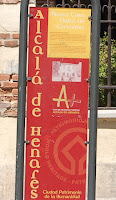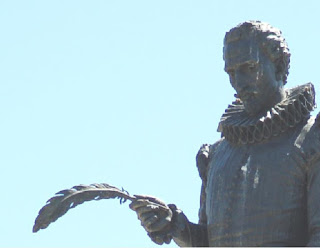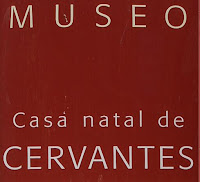Other Resources on Cervantes' Spain
 Just as I
glimpsed an escarpment that might echo the time of the writer’s
childhood, the Cercanía arrived at the barren “A. de Henares” platform.
Just as I
glimpsed an escarpment that might echo the time of the writer’s
childhood, the Cercanía arrived at the barren “A. de Henares” platform.
 |
| Merely the work of birds or Cervantes' Tears ? |
I was stiff,
the seat was hard, the air was stale; this all supported my assumption that the
train ride would be the dull part of the day.
Neither the
bustle and tempo of the Metro nor the soothing brown-green flow of the
inter-urban AVE, the Renfe Cercanías, short-distance trains that connect the
city centre with Madrid’s “cerca” regions, are utilitarian and plain.
I took my ride
on a Cercanía to reach Alcalá
de Henares, the town that was the 16th century birthplace of poet,
playwright, and Don Quixote
author Miguel de
Cervantes.
The Cercanía
coach no doubt serves commuters well, but it wants as a
vehicle for riding back in time. The 21st century is reinforced along the route by graffiti on overpasses and warehouse walls. Hard to think about history,
romance, and philosophy while looking out this train window.
 Just as I
glimpsed an escarpment that might echo the time of the writer’s
childhood, the Cercanía arrived at the barren “A. de Henares” platform.
Just as I
glimpsed an escarpment that might echo the time of the writer’s
childhood, the Cercanía arrived at the barren “A. de Henares” platform.
While the
signs confirmed that I had taken
the right train, my confidence faded when I realized that Alcalá de Henares was a bigger town than I imagined with streets running in all
directions, all outside my tattered Madrid street map. My narrow mission might have justified taking a cab. But I saw no taxis nor obvious taxi
stands by the station.
I bought a
bottle of water, sought directions in bite-sized Spanish from the woman at the snack stand, who was happy to talk about
her town, but had no maps. With a smile, she pointed at the wall and
then my pack. Finally, I understood that she was suggesting that I take a
digital photo of the Town Map on the train station wall, and I did.
With my map in
my camera, I headed into what looked like downtown Alcalá de Henares confident that if I walked in straight lines, I could find my way
back to the station before nightfall.
 Cervantes
family enjoyed relative affluence, and the reconstructed rooms in the house try
to suggest that his career and artistic works were stimulated by early life
exposure to literature, art, toys, puppets, and stories of Moors and Crusaders
in his Alcala de Henares home.
Cervantes
family enjoyed relative affluence, and the reconstructed rooms in the house try
to suggest that his career and artistic works were stimulated by early life
exposure to literature, art, toys, puppets, and stories of Moors and Crusaders
in his Alcala de Henares home.

 I realized
instantly what it was. As confirmed by the text on the stone and a plaque next
to the figures, it was a memorial to victims of the 11 March 2004 train
bombings.
I realized
instantly what it was. As confirmed by the text on the stone and a plaque next
to the figures, it was a memorial to victims of the 11 March 2004 train
bombings.
 As all news
reports of the bombings emphasized in March 2004 and after, the attacks were
targeted on “commuter trains” – the Cercanías.
As all news
reports of the bombings emphasized in March 2004 and after, the attacks were
targeted on “commuter trains” – the Cercanías.
 Riding back to
Madrid, I was not thinking about a need for atmosphere nor any wanting in the
mood on the train.
Riding back to
Madrid, I was not thinking about a need for atmosphere nor any wanting in the
mood on the train.
 |
| Make-shift Photo Map |
It did not take long to see that
I was headed the right way and to sense a place with pride in its history, not
only in its association with the Quixote creator, but its architecturally
impressive University
of Alcalá and a city centre that has clearly been around for centuries.
The transition
from the suburban now to the venerated old begins around the steely modern art
representation of Don Quixote in a traffic circle and reaches its crescendo in
the Plaza de Cervantes with its requisite mini-Trafalgar pillar crowned by a
statue of the writer.
I learned
later that there was a lot of other history in the town stretching back to the
trials of two child-martyrs in Roman times and that there were other
author-related sites to be studied by other more dedicated pilgrims. But my
attention was pulled instead to the seemingly ordinary people in the Plaza: a
street band playing lively music, some adults singing, and children dancing. It
was mid-week and during non-siesta working hours.
The mood was that of a festival or holiday.
It may have been a special event, but it just seemed to me to be a regular kind of activity and possibly a natural part of a late summer day in Alcalá de Henares and perhaps other towns like this.
The mood was that of a festival or holiday.
It may have been a special event, but it just seemed to me to be a regular kind of activity and possibly a natural part of a late summer day in Alcalá de Henares and perhaps other towns like this.
 |
| Quixote in Symbolic Steel |
It feels like
a smaller place when you are in the town centre. No highrise office towers,
noisy four-lane traffic snarls, nor blaring brand names. It is, instead, a
forest of shops, small businesses, and restaurants. With the help of the street
name in the brochure and the tourist information centre, I was able to find the
Casa de Cervantes and Museum on the Calle Major within this jumble.
In drawing a
map on scrap paper, the obliging man in the tourist office explained that the
author probably wanted to stay in Alcalá de Henares longer, but during that
time, writers sadly had to head off to the big city and the patronage of the
churches and the profits of the palace. When I said that no one would willingly
leave such a great place without powerful inducement, he nodded.
Although the
two-story stone building fronted by a seated Don Quixote and Sancho Panza
statues seems odd at first, situated as it is amidst the souvenir shops and
bars, the Casa
de Cervantes Museum is , for the most part, much as you might anticipate.
Not large by the standard of today’s super structures, but easy to accept as
having been one of the bigger and better homes of mid-16th century Spain.
 Cervantes
family enjoyed relative affluence, and the reconstructed rooms in the house try
to suggest that his career and artistic works were stimulated by early life
exposure to literature, art, toys, puppets, and stories of Moors and Crusaders
in his Alcala de Henares home.
Cervantes
family enjoyed relative affluence, and the reconstructed rooms in the house try
to suggest that his career and artistic works were stimulated by early life
exposure to literature, art, toys, puppets, and stories of Moors and Crusaders
in his Alcala de Henares home.
The guides in
the museum make a point of showing guests the exposed tempura painting on one
of the walls which, I was told, had been uncovered in restorations about a
decade ago. It has been analyzed and carbon-dated with results that support
those that believe that this house was owned by the Cervantes family and
existed at the time of the writer’s birth.
 |
| Silhouette surveying Plaza de Cervantes |
The
furnishings are refined and authentic, and the Museum’s aura of history is
augmented by a dimly lit room of rare versions of Don Quixote: some dating back
several centuries. Not on display, but available to approved researchers, is a
particularly rare version of the book printed in 1605 without authority in
Portugal in the year that the first Spanish edition of Part I of Don Quixote came
out.
The museum does not, it appears, have one of those few surviving true first edition Quixotes; and this may be for the best as it would demand an extra level of security, screening of visitors, and costs all of which would threaten the ease of the currently free visit to the museum.
I guess that I was visibly disappointed when told that visitors were not allowed to take photos inside the house and perhaps a little too persistent in my broken Spanish inquiry. I felt compelled to explain that I was not interested in photographing the books or the contents of the museum, but simply to be photographed inside the home.
Seeing my face and listening to my Espanenglish, the woman at the entrance said, with a modest accent, but strong enough that I appreciated her effort to joke, “bwell, señor, thee patio eez note eesacklee in thee bildeeng.” She took my picture sitting on a bench in the patio, which I convinced myself was the place where Cervantes’ mother rested in childbirth, at the very centre of the building, but not “eesackly”inside it.
The museum does not, it appears, have one of those few surviving true first edition Quixotes; and this may be for the best as it would demand an extra level of security, screening of visitors, and costs all of which would threaten the ease of the currently free visit to the museum.
I guess that I was visibly disappointed when told that visitors were not allowed to take photos inside the house and perhaps a little too persistent in my broken Spanish inquiry. I felt compelled to explain that I was not interested in photographing the books or the contents of the museum, but simply to be photographed inside the home.
Seeing my face and listening to my Espanenglish, the woman at the entrance said, with a modest accent, but strong enough that I appreciated her effort to joke, “bwell, señor, thee patio eez note eesacklee in thee bildeeng.” She took my picture sitting on a bench in the patio, which I convinced myself was the place where Cervantes’ mother rested in childbirth, at the very centre of the building, but not “eesackly”inside it.

As I walked
back to the train station through more music, more food smells, and more
crowds, I wondered if I had gained anything from seeing another stone building,
faded books, and old artifacts and whether it was a day well spent. Direct
answers did not come to my mind, but the question caused me to think of the
nice people: the friendly woman at the train station, the older guy in the
information office, the children dancing, the museum guide who took my picture.
As I thought about the ordinary people of Alcalá de Henares, I came up to the
Cercanías station, this time from the northeast side and from this approach, I
saw another group of local citizens. These people were cold, still, and lifeless.
Statues in another monument.
 I realized
instantly what it was. As confirmed by the text on the stone and a plaque next
to the figures, it was a memorial to victims of the 11 March 2004 train
bombings.
I realized
instantly what it was. As confirmed by the text on the stone and a plaque next
to the figures, it was a memorial to victims of the 11 March 2004 train
bombings.
Most of the
world easily recalls the day - when terrorist bombs exploded on four trains in
and around Madrid, killing almost 200 people, injuring 1800, and traumatizing
thousands more who climbed out over the wreckage and blood of the other
passengers. They were people like and possibly even were some of the people
that I had encountered that day.
 As all news
reports of the bombings emphasized in March 2004 and after, the attacks were
targeted on “commuter trains” – the Cercanías.
As all news
reports of the bombings emphasized in March 2004 and after, the attacks were
targeted on “commuter trains” – the Cercanías.
 Riding back to
Madrid, I was not thinking about a need for atmosphere nor any wanting in the
mood on the train.
Riding back to
Madrid, I was not thinking about a need for atmosphere nor any wanting in the
mood on the train.
There was no lack of either as I thought about how these
nice people had to regroup, return to work, and re-ride their blood-stained rails
in the days and weeks that followed those attacks in order, like the imagined Cervantes
and the graffiti writing youth, to continue the struggle, to make their way in
the big city, and to maintain the spirit of historic communities like Alcalá de
Henares.